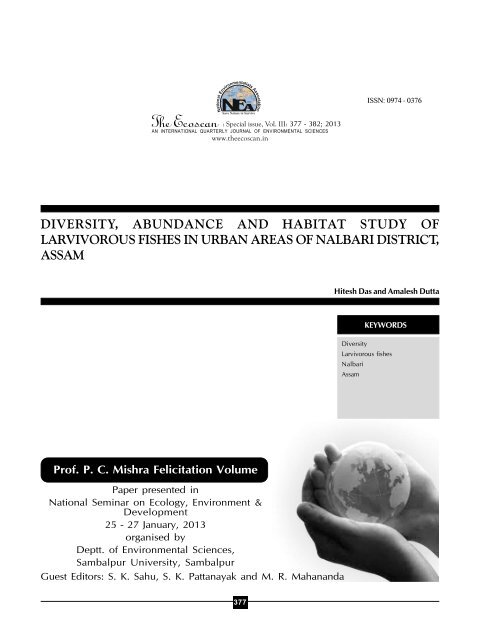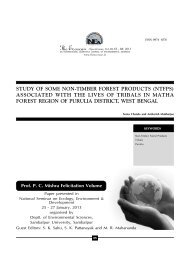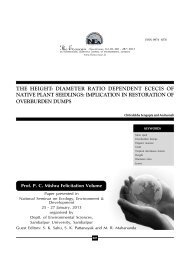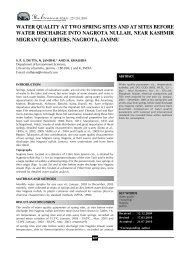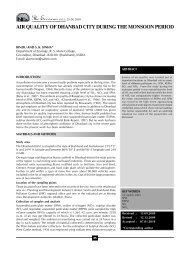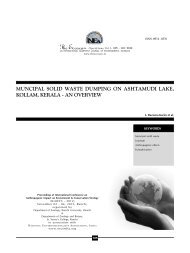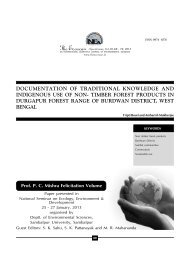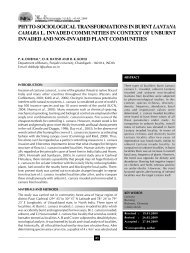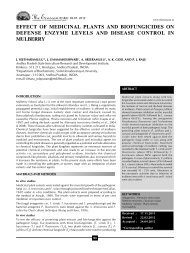Hitesh Das.pmd - An International Quarterly Journal of ...
Hitesh Das.pmd - An International Quarterly Journal of ...
Hitesh Das.pmd - An International Quarterly Journal of ...
You also want an ePaper? Increase the reach of your titles
YUMPU automatically turns print PDFs into web optimized ePapers that Google loves.
ISSN: 0974 - 0376<br />
NSave Nature to Survive<br />
: Special issue, Vol. III: 377 - 382; 2013<br />
AN INTERNATIONAL QUARTERLY JOURNAL OF ENVIRONMENTAL SCIENCES<br />
www.theecoscan.in<br />
DIVERSITY, ABUNDANCE AND HABITAT STUDY OF<br />
LARVIVOROUS FISHES IN URBAN AREAS OF NALBARI DISTRICT,<br />
ASSAM<br />
<strong>Hitesh</strong> <strong>Das</strong> and Amalesh Dutta<br />
KEYWORDS<br />
Diversity<br />
Larvivorous fishes<br />
Nalbari<br />
Assam<br />
Pr<strong>of</strong>. P. C. Mishra Felicitation Volume<br />
Paper presented in<br />
National Seminar on Ecology, Environment &<br />
Development<br />
25 - 27 January, 2013<br />
organised by<br />
Deptt. <strong>of</strong> Environmental Sciences,<br />
Sambalpur University, Sambalpur<br />
Guest Editors: S. K. Sahu, S. K. Pattanayak and M. R. Mahananda<br />
377
NSave Nature to Survive<br />
QUARTERLY<br />
HITESH DAS* AND AMALESH DUTTA<br />
Department <strong>of</strong> Zoology, Gauhati University,<br />
Guwahati - 781 014<br />
E-mail:hiteshdas11@gmail.com<br />
ABSTRACT<br />
Both indigenous and exotic fishes are used as<br />
biological control agents <strong>of</strong> mosquitoes<br />
throughout the country. Such mosquito larvae<br />
eating fishes are found in all types <strong>of</strong> freshwater<br />
habitats. A study was conducted to assess the<br />
relative abundance, diversity and habitat <strong>of</strong><br />
these fishes from different aquatic habitats like<br />
ponds, wetlands, irrigation canal etc. <strong>of</strong><br />
Nalbari town area <strong>of</strong> Nalbari district during<br />
2010-2011. During survey period altogether<br />
21 species <strong>of</strong> larvivorous fishes belongs to 15<br />
genera, 11 families and 5 orders were<br />
observed. Present study indicates that order<br />
Perciformes contributes highest and<br />
Osteoglossiformes along with Siluriformes<br />
contributes lowest species composition.<br />
Among these fishes Channa gachua was the<br />
dominant species found from all types <strong>of</strong><br />
habitats, while Puntius sp. and Notopterus<br />
notopterus were collected higher from only<br />
those habitats with high dissolved oxygen<br />
content (6.8 ± 0.21- 8.6± 0.04 mg/L).<br />
INTRODUCTION<br />
Larvivorous fish are those that feed on immature stages <strong>of</strong> mosquitoes. According<br />
to Job (1940), larvivorous fish must be small, hardy and capable <strong>of</strong> getting about<br />
easily in shallow waters among thick weeds where mosquitoes find suitable<br />
breeding grounds. They must be drought resistant and capable <strong>of</strong> flourishing in<br />
both deep and shallow waters as well as living in drinking water tanks and pools<br />
without contaminating the water. They must have the ability to withstand rough<br />
handling and transportation for long distances. Larvivorous fish must be prolific<br />
breeders having shorter span <strong>of</strong> life cycle. They must breed freely and successfully<br />
in confined waters. Larvivorous fish should be surface feeders and carnivorous<br />
in habit and should have a predilection for mosquito larvae even in the presence<br />
<strong>of</strong> other food materials. <strong>An</strong>other important criterion <strong>of</strong> all larvivorous species<br />
should be its appearance. They should not be brightly coloured or attractive.<br />
They should be compatible with the existing fish life in that environment. Above<br />
all, they should have no food value, so that the fish-eating people discard them.<br />
The use <strong>of</strong> fish for controlling mosquitoes was an important tool in the pre-DDT<br />
era (Floore, 2006; Walker and Lynch, 2007). Typically fish were introduced into<br />
all potential mosquito breeding habitats, including rice fields, marshes, dams,<br />
canals and ponds (Hadjinicolaou and Betzios, 1973; Motabar, 1978). Biological<br />
control, particularly using larvivorous fish, was important to malaria control<br />
programmes in the 20 th century, particularly in urban and periurban areas for<br />
immediate use in developed and developing countries (Gratz and Pal, 1998). It<br />
has a very positive role to play in the integrated control methodologies in which<br />
both pesticides and fish or other biotic agents have their own roles (Mulla, 1961).<br />
Biological control refers to the introduction or manipulation <strong>of</strong> organisms to<br />
suppress vector populations. A wide range <strong>of</strong> organisms helps to regulate mosquito<br />
populations naturally through predation, parasitism and competition. As biological<br />
mosquito control agents, larvivorous fish (i.e., those that feed on immature stages<br />
<strong>of</strong> mosquitoes) are being used extensively all over the world since the early<br />
1900s (pre DDT era) (Raghavendra and Subbarao, 2002). There was no significant<br />
work done on larvivorous fishes from Assam. Only single reference is documented<br />
in this respect from the work <strong>of</strong> Sheikh et al. (1991). The urban areas <strong>of</strong> Nalbari<br />
town generally not regarded as a malaria dominant zone, but in previous years<br />
<strong>An</strong>opheles minimus, a common species among malaria vector mosquitoes was<br />
reported from this area (Prakash et al., 1995). Therefore present work was attempt<br />
to study on the Nalbari town <strong>of</strong> Nalbari district, Assam.<br />
MATERIALS AND METHODS<br />
*Corresponding author<br />
Study area<br />
The Nalbari town is the head quarter <strong>of</strong> Nalbari district. It lies between 26º44/N<br />
latitude to 91º44/E longitude. There are diversified aquatic habitats such as ponds,<br />
marshy wetlands; irrigation canals etc. are located in urban areas <strong>of</strong> this town.<br />
378
LARVIVOROUS FISHES OF NALBARI DISTRICT, ASSAM<br />
Table1: Seasonal availability <strong>of</strong> fish species in urban areas <strong>of</strong> Nabari district<br />
TaxonomicPosition Name <strong>of</strong> the species PM (N ) M (N) RM(N) W(N)<br />
Order<br />
Osteoglossiformes<br />
Family<br />
Notopteridae Notopterus notopterus (Pallas) 10 11 12 8<br />
Order<br />
Cypriniformes<br />
Family<br />
Cyprinidae Amblypharygodon mola (Hamilton-Buchanan) 20 42 31 24<br />
Rasbora daniconius (Hamilton) 10 15 8 11<br />
Esomus danrica (Hamilton) 22 34 14 21<br />
Puntius sophore (Hamilton) 31 45 43 21<br />
P. ticto (Hamilton) 10 15 8 11<br />
Order<br />
Perciformes<br />
Family<br />
Ambassidae Chanda nama (Hamilton) 12 17 12 13<br />
Pseudambassis ranga (Hamilton) 13 18 10 14<br />
<strong>An</strong>abantidae <strong>An</strong>abus testudenius (Bloch) 14 18 11 8<br />
Cichlidae Oreochromis mossambicus (Peters) 33 44 23 32<br />
Osphronemidae Trichogaster fasciatus (Schneider) 21 20 14 9<br />
T. chuna (Hamilton- Buchanan) 14 31 21 12<br />
T. lalius (Hamilton- Buchanan) 11 23 12 8<br />
Channidae Channa gachua (Bloch- Schneider) 40 65 44 32<br />
C. punctata (Bloch) 23 33 24 25<br />
C. stewartii (Playfair) 8 10 7 8<br />
C. striata (Bloch) 7 9 6 7<br />
Gobiidae Glossogobius giuris (Hamilton- Buchanan) 12 18 6 8<br />
Order<br />
Siluriformes<br />
Family<br />
Bagridae Mustus vittatus (Bloch) 14 23 18 19<br />
Order<br />
Cyprinodontiformes<br />
Family<br />
Aplochelidae Aplocheilus panchax (Hamilton) 16 34 19 21<br />
Family<br />
Poecilidae Gambusia affinis (Baird and Girard) 21 38 17 33<br />
Note- PM= Pre-monsoon, M= Monsoon, RM= Retreating monsoon, W= winter, N=Number <strong>of</strong> fish species<br />
Sampling <strong>of</strong> fish<br />
Fish samples were collected during the period <strong>of</strong> 2009-2010<br />
in four different seasons viz., pre-monsoon (March-May),<br />
monsoon (June-September), retreating monsoon (October-<br />
November) and winter (December-February) after Borthakur<br />
(1986).Sampling was done from the study site with the help <strong>of</strong><br />
cast net, dip net, local bamboo traps and hooks etc. The fish<br />
samples were preserved in 5% aqueous formalin solution (v/<br />
v) directly.<br />
Identification<br />
Identification <strong>of</strong> collected fish samples were done after Jayaram<br />
(1999), Talwar and Jhingran (1991), Nath and Dey (2000).<br />
The latest scientific names <strong>of</strong> the fish species were followed<br />
after the website www. Calacademy. org/res/ ichthyo/<br />
catalogue.<br />
Diversity indices<br />
Species diversity <strong>of</strong> ichthy<strong>of</strong>auna was estimated using<br />
Shannon-Weiner index (H) after Shannon-Weiner (1949) and<br />
Evenness index (E) was estimated following Pielou (1966).<br />
Dominance status <strong>of</strong> various species was described on the<br />
basis <strong>of</strong> relative abundance following Engelmann’s scale<br />
(Engelmann, 1973).<br />
Habitat Study<br />
The habitat study <strong>of</strong> larvivorous fishes was carried out on the<br />
basis <strong>of</strong> both primary and secondary data. The primary data<br />
were collected from the field through survey and spot<br />
observation. Secondary data were collected through<br />
observation and interview with the fishers through<br />
questionnaire. More over habitat <strong>of</strong> each species was traced<br />
by means <strong>of</strong> tolerance level <strong>of</strong> dissolved oxygen in each type<br />
<strong>of</strong> habitat.<br />
Sampling <strong>of</strong> water<br />
The water samples were collected during the period <strong>of</strong> 2009-<br />
2010 in monthly intervals. Dissolved oxygen analysis was<br />
performed at the sites by Winkler’s modified technique<br />
according to APHA (1998).<br />
RESULTS AND DISCUSSION<br />
A total <strong>of</strong> 21 species <strong>of</strong> larvivorous fishes belong to 5 orders,<br />
11 families and 15 genera have been recorded from the urban<br />
areas <strong>of</strong> Nalbari district during the study period. The fish species<br />
<strong>of</strong> these areas belong to the following five orders-<br />
379
HITESH DAS AND AMALESH DUTTA<br />
Table 2: Dominant status <strong>of</strong> different fish species in urban areas <strong>of</strong> Nabari district<br />
TaxonomicPosition Name <strong>of</strong> the species Number Relative Dominancestatus<br />
abundance (R A) %<br />
Order<br />
Osteoglossiformes<br />
Family<br />
Notopteridae Notopterus notopterus (Pallas) 41 2.52 Recedent<br />
Order<br />
Cypriniformes<br />
Family<br />
Cyprinidae Amblypharygodon mola (Hamilton-Buchanan) 117 7.18 Subdominant<br />
Rasbora daniconius (Hamilton) 44 2.70 Recedent<br />
Esomus danrica (Hamilton) 91 5.58 Subdominant<br />
Puntius sophore (Hamilton) 140 8.59 Subdominant<br />
P. ticto (Hamilton) 44 2.70 Recedent<br />
Order<br />
Perciformes<br />
Family<br />
Ambassidae Chanda nama (Hamilton) 54 3.31 Subdominant<br />
Pseudambassis ranga (Hamilton) 55 3.37 Subdominant<br />
<strong>An</strong>abantidae <strong>An</strong>abus testudenius (Bloch) 51 3.10 Recedent<br />
Cichlidae Oreochromis mossambicus (Peters) 132 8.10 Subdominant<br />
Belontiidae Trichogaster fasciatus (Schneider) 64 3.93 Subdominant<br />
T. chuna (Hamilton- Buchanan) 78 4.79 Subdominant<br />
T. lalius (Hamilton- Buchanan) 54 3.31 Subdominant<br />
Channidae Channa gachua (Bloch- Schneider) 181 11.10 Dominant<br />
C. punctata (Bloch) 105 6.44 Subdominant<br />
C. stewartii (Playfair) 33 2.02 Recedent<br />
C. striata (Bloch) 29 1.78 Recedent<br />
Gobiidae Glossogobius giuris (Hamilton- Buchanan) 44 2.70 Recedent<br />
Order<br />
Siluriformes<br />
Family<br />
Bagridae Mustus vittatus (Bloch) 74 4.54 Subdominant<br />
Order<br />
Cyprinodontiformes<br />
Family<br />
Aplochelidae Aplocheilus panchax (Hamilton) 90 5.52 Subdominant<br />
Family<br />
Poecilidae Gambusia affinis (Baird and Girard) 109 6.69 Subdominant<br />
RA 31.7 % = Eudominant (Engelmann, 1973)<br />
Table 3: Seasonal variation in species abundance, species richness, species diversity and evenness <strong>of</strong> fish species in urban areas <strong>of</strong> Nabari district<br />
Seasons Pre-monsoon Monsoon Retreating monsoon Winter<br />
Number <strong>of</strong> individuals (N)(Species Abundance) 362 563 360 345<br />
Number <strong>of</strong> species (Richness) 21 21 21 21<br />
Species diversity (H) 3.25 2.86 2.47 2.90<br />
Evenness (E) 0.55 0.45 0.42 0.50<br />
Table 4: Different types <strong>of</strong> habitat <strong>of</strong> larvivorous fishes with dissolved<br />
oxygen level<br />
Habitat Type<br />
Dissolved Oxygen (mg/L)<br />
Pond (P) 8.6 ± 0.04<br />
Marshy Wetlands (MW) 5.9 ± 0.20<br />
Deep Irrigation Canals (DIC) 6.8 ± 0.21<br />
Shallow Irrigation Canals (SIC) 4.5 ± 0.18<br />
Rivulets (R) 7.2 ± 0.11<br />
Crop Fields (CF) 5.8 ± 0.30<br />
Osteoglossiformes, Cypriniformes, Siluriformes, Perciformes<br />
and Cyprinodontiformes. Out <strong>of</strong> these 21 species, 5 belong to<br />
family Cyprinidae, followed by Channidae (4), Osphronemidae<br />
(3), Ambassidae (2), Notopteridae (1), <strong>An</strong>abantidae (1),<br />
Cichlidae (1), Gobiidae (1), Bagridae (1), Aplocheilidae (1),<br />
and Poecilidae (1). The collected fish species from different<br />
types <strong>of</strong> habitats <strong>of</strong> Nalbari town are depicted in Table 1.<br />
Among all the orders <strong>of</strong> fish fauna Cypriniformes were found<br />
to be the order with highest species composition (56%) and<br />
order Osteoglossiformes along with Cyprinodontiformes with<br />
lowest species composition (5%) respectively.<br />
Among these species, 11 species assessed as subdominant, 7<br />
as recedent category and 1 species as dominant category.<br />
Channa gachua (Bloch- Schneider) was the highest dominant<br />
(RA-11.10 %) and Channa striata (Bloch) (RA-1.78 %) was the<br />
least dominant species. All the larvivorous fish species with<br />
their dominance status plotted in Table 2. Species abundance<br />
found maximum during monsoon and minimum during<br />
winter. Species richness noted equal in all seasons. Species<br />
diversity (H) estimated maximum during pre-monsoon and<br />
minimum during retreating monsoon. Evenness observed<br />
maximum during pre-monsoon and minimum during<br />
380
LARVIVOROUS FISHES OF NALBARI DISTRICT, ASSAM<br />
Table 5: Habitat types <strong>of</strong> larvivorous fish species in urban areas <strong>of</strong> Nabari district<br />
Name <strong>of</strong> the species P MW DIC SIC R CF<br />
Notopterus notopterus (Pallas) + - - - - -<br />
Amblypharygodon mola + - + - + +<br />
Rasbora daniconius (Hamilton) + - + - + -<br />
Esomus danrica (Hamilton) + - + - + +<br />
Puntius sophore (Hamilton) + - + - + -<br />
P. ticto (Hamilton) + - + - + -<br />
Chanda nama (Hamilton) + - + - - -<br />
Pseudambassis ranga (Hamilton) + - + - - -<br />
<strong>An</strong>abus testudenius (Bloch) + + + - + -<br />
Oreochromis mossambicus (Peters) + + + - - -<br />
Trichogaster fasciatus (Schneider) + + + - + +<br />
T. chuna (Hamilton- Buchanan) + + + - + +<br />
T. lalius (Hamilton- Buchanan) + + + - + +<br />
Channa gachua (Bloch- Schneider) + + + + + +<br />
C. punctata (Bloch) + + + - + +<br />
C. stewartii (Playfair) - + + - - -<br />
C. striata (Bloch) - + + - - -<br />
Glossogobius giuris (Hamilton- Buchanan) + - + - + -<br />
Mustus vittatus (Bloch) - - - - + -<br />
Aplocheilus panchax (Hamilton) + + - + - +<br />
Gambusia affinis (Baird and Girard) - - + + - -<br />
Note: + = present; - = absent<br />
Osteoglossiformes Cypriniformes Perciformes<br />
Siluriformes Cyprinodontiformes<br />
Recedent Subdominant Dominant<br />
Figure 1: Larvivorous fish species <strong>of</strong> urban areas <strong>of</strong> Nalbati Town (%<br />
per order)<br />
retreating monsoon. All the results regarding diversity and<br />
abundance <strong>of</strong> larvivorous fish species <strong>of</strong> Nalbari town area<br />
are depicted in Table 3. All the larvivorous fish species were<br />
collected from different types <strong>of</strong> freshwater aquatic habitats<br />
like pond, marshy wetlands, deep irrigation canals, shallow<br />
irrigation canals, rivulets and crop fields <strong>of</strong> Nalbari town area.<br />
The values <strong>of</strong> dissolved oxygen <strong>of</strong> each habitat are plotted in<br />
Table 4.<br />
Among all the larvivorous fishes Channa gachua was the<br />
dominant species collected from all types <strong>of</strong> aquatic habitats<br />
<strong>of</strong> Nalbari town. This species collected from habitats in which<br />
dissolved oxygen level ranged between 4.5± 0.18 mg/L and<br />
8.6 ± 0.04 mg/L and regarded as a hardy and dissolved<br />
oxygen tolerant species. On the other hand species like Puntius<br />
sophore, P. ticto and Notopterus notopterus were collected<br />
higher from only those habitats with high dissolved oxygen<br />
content (6.8 ± 0.21- 8.6± 0.04 mg/L).<br />
Although the young ones <strong>of</strong> Channa gachua feed on mosquito<br />
larvae, the adults feed on small feeds on smaller fish and it is<br />
Figure 2: Dominance status <strong>of</strong> larvivorous fishes <strong>of</strong> urban areas <strong>of</strong><br />
Nalbari Town (% per category)<br />
therefore, not suitable for anti-mosquito operations (Khanna,<br />
1970). Predatory fishes like Channa, Notopterus and Mystus<br />
whose fry may destroy mosquito larvae but whose adults may<br />
predate upon other fish including larvicidal fish species.<br />
Gambusia affinis collected from only deep and shallow<br />
irrigation canals, while Aplocheilus panchax collected from<br />
ponds, marshy wetlands, shallow irrigation canals and crop<br />
fields. Both these two species are typical surface feeders, which<br />
fulfill the characteristic features <strong>of</strong> larvivorous fish (Hora and<br />
Mukherjee, 1938).<br />
Among the other fishes, species like Amblypharyngodon mola<br />
and Rasbora daniconius are sub-surface feeders. Column<br />
feeders like Puntius sp., Trichogaster sp., Chanda, <strong>An</strong>abas,<br />
etc., which feed on mosquito larvae when chance permits. All<br />
the larvivorous fishes and their habitats are depicted in Table 5.<br />
REFERENCES<br />
APHA 1998. Standard methods for the examination <strong>of</strong> water and<br />
381
HITESH DAS* AND AMALESH DUTTA<br />
wastewater including bottom sediment and sluge. 20 th edition,<br />
American Public Health Association, (New York).<br />
Borthakur, M. 1986. Weather and climate in N. E. India. Northeastern<br />
Geographer. 18(1 and 2): 20-27.<br />
Engelmann, H. D. 1973. Untersuchungen zur Erfassung<br />
predozoogener komponenten im definierten. Okosystem.<br />
Forschungen. Staatl. Mus. Naturkde., Gorlitz.<br />
Floore T. G. 2006. Mosquito larval control practices: past and present.<br />
J. Am Mosq Control. 22: 527–533.<br />
Gratz, N. G. and Pal, R. 1988. Malaria vector control: larviciding.<br />
In: Wernsdorfer WH, McGregor I, Ed. Malaria: Principles & practice<br />
<strong>of</strong> malariology. Edinburgh, UK: Churchill Livingstone. pp. 1213-26.<br />
Hadjinicolaou, J. and Betzios, B. 1973. Gambusia fish as a means <strong>of</strong><br />
mosquito control <strong>of</strong> <strong>An</strong>opheles sacharovi in Greece. World Health<br />
Organization; Geneva, Switzerland.<br />
Hora, S. L. and Mukherjee, D. D. 1938. The absence <strong>of</strong> millions,<br />
Lebistes reticulates (Peters) in India. Malaria Bureau No.4, Health<br />
Bulletin, Delhi. 12:1-49.<br />
Jayaram, K. C. 1999. The fresh water fishes <strong>of</strong> Indian region. Narendra<br />
Publishing House, New Delhi.<br />
Job, T. J. 1940. <strong>An</strong> investigation <strong>of</strong> the nutrition <strong>of</strong> the perches <strong>of</strong> the<br />
Madras coast. Rec Mind Mus. 42: 289-364.<br />
Khanna, S. S. 1970. <strong>An</strong> Introduction to Fishes, Central Book Depot,<br />
Allahabad, pp 448-449.<br />
Motabar, M. 1978. Larvivorous fish, Gambusia affinis: a review.<br />
World Health Organization; Geneva, Switzerland.<br />
Mulla, M. S. 1961. Mosquito control investigations with emphasis on<br />
integration <strong>of</strong> chemical and biological control in mosquito abatement.<br />
29 th Proc Pap <strong>An</strong>n Con Calif Mosquito Contr Assoc. pp. 1-4.<br />
Nath, P. and Dey, S. C. 2000. Fish and Fisheries <strong>of</strong> North Eastern<br />
India (Arunachal Pradesh), 217 p. Narendra Publishing House (New<br />
Delhi).<br />
Pielou, E. C. 1966. Ecological Diversity. Wiley Inter Science. London.<br />
Prakash, A., Mohapatra, P. K. and Srivastava, V. K. 1995. Vector<br />
incrimination in Tamulpur primary health centre, district Nalbari,<br />
lower Assam during malaria outbreak Indian J. Med Res. 103:146-9.<br />
Raghavendra, K. and Subbarao, S. K. 2002. Chemical insecticides in<br />
malaria vector control in India. ICMR Bull. 32: 1-7.<br />
Shanon, C. E. and Wiener, W. 1949. The mathematical theory <strong>of</strong><br />
communication. University IIinois Press, Urbana.<br />
Sheikh, M. S., Dutta, A. and Kalita, J. 1991. Relative Efficiency <strong>of</strong><br />
Mosquitocidal Activities <strong>of</strong> Certain Indigenous Fish Species,<br />
Environment & Ecology. 9 (4): 1011-1015<br />
Talwar, P. K. and Jhingran, A. G. 1991. Inland fishes Vol. 1 and 2,<br />
Oxford and IBH Publishing Co. Pvt. Ltd. New Delhi.<br />
Walker, K. and Lynch, M. 2007. Contributions <strong>of</strong> <strong>An</strong>opheles larval<br />
control to malaria suppression in tropical Africa: review <strong>of</strong> achievements<br />
and potential. Med Vet Entomol. 21: 2–21.<br />
382


